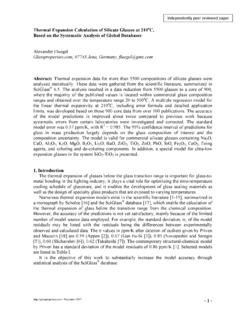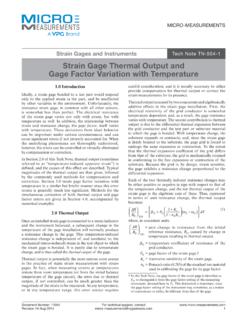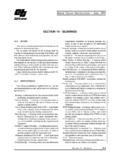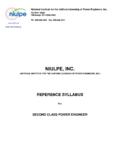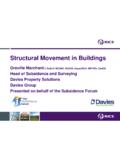Transcription of Cracks in Concrete Is It a Design Issue Or Just ‘Poor ...
1 KMS / TECHNICAL DEPARTMENT. TECHNICAL NOTE 015. Cracks in Concrete . Is It a Design Issue Or just poor ' workmanship ? We excel through experience and learning Version 01, Oct 2014. Version 01, Mar 2011. Keywords Similar to most other materials, Concrete will expand or contract Flexural Cracks , Early-Age Thermal Cracks , Drying Shrinkage in response to a temperature change, for example. In the Cracks , Plastic Shrinkage Cracks , Free / Restrained Contraction context of this note, contraction (or shrinkage) of Concrete is the prime concern. As long as contraction is free to take place, tensile stress will not develop in Concrete elements. However, Synopsis in reality, contraction movement will always be restrained in Contrary to prestressed Concrete , Cracks in reinforced (or one way or another, causing the development of tensile stress.)
2 Unreinforced) Concrete are inescapable. It has been quite If the tensile stress is greater than the tensile strength, common to presume that Cracks are formed as a result of poor ' Concrete Cracks . workmanship , and hence Contractors are required to come up with suitable remedial measures, and to bear the associated NB . time and cost implications. Noting that workmanship could not It must be noted that the provision of reinforcing bars possibly be the sole cause, this technical note attempts to (rebars) in Concrete can only help control the crack spacing explain the common types of Cracks and their causes, with and width, but it will never eliminate Cracks . If the rebars particular emphasis on those that are more Design -oriented for some reasons were under-provided such that the tensile where Contractors have no practical input. stress so developed in Concrete could not be effectively redistributed, the resulting crack(s) would be more localised with large width.
3 Introduction Prior to discussing Cracks in Concrete , it is instructive to review the following behaviour. Crack pattern: with too little rebars Original length of Concrete Crack pattern: Free contraction, with adequate rebars no stress develops Free (or unrestrained). contraction Restraint With regard to development of cracking, restraint to contraction movement can be grouped into two principle types: Restrained and hence no External Restraint and Internal Restraint. Estimating it wrong free contraction, may result in wasteful over-provision of rebars, or under- tensile stress develops provision leading to unacceptable cracking. Contraction movement could be caused by thermal effects, reduction in volume of hardened Concrete (ie, shrinkage), etc. If tensile stress is greater External Restraint than tensile strength, Concrete Cracks External restraint to a newly cast Concrete element can be subdivided into (i) Continuous Edge Restraint, (ii) End Restraint and (iii) Intermittent Restraint.
4 In many cases, all three forms of restraint may act together. These are illustrated in the following figures. TECHNICAL NOTE 015. Version 01, Oct 2014. 01. KMS / TECHNICAL DEPARTMENT. In cut-&-cover tunnels, walls (new section) are usually cast onto the base slab (old section). This is a classic example of continuous edge restraint;. For slabs cast in hit-&-miss fashion, infill slab panels are subjected to end restraint. [Source: Internet] [Source: Internet]. i) Continuous Edge Restraint Internal Restraint Walls (new section) cast onto rigid foundations, adjacent Change in temperature profile across a thick section can sections of slabs, or tunnel lining (old sections) cause one part of the section to restrain the movement of another part of the same section. For thick sections, the surface zone cools down more quickly Movement direction than the core this would be particularly so if formwork (or New section Restraint insulation) was removed too soon.
5 The rapid cooling and direction contraction of the surface zone is restrained by the hot interior, and therefore the surface Cracks . These surface Cracks would Old be expected to close up as the core cools down. section By the time Concrete has reached the ambient temperature from the peak, the surface Cracks will have closed sufficiently to be able to transmit compressive stresses, and in extreme cases, internal Cracks occurs as a result of tensile stresses developed in the core. That is, by this time, the core contraction is restrained by the surface zones working in compression. ii) End Restraint Walls or slabs cast as infills Surface zone Cracks Surface zone Cracks closed up Surface Old zone section New section Old section Heating phase Cooling phase Types of Concrete Cracks Generally speaking, Cracks in Concrete can be iii) Intermittent Restraint categorised into the following types: Slabs cast on piles, suspended slabs cast on columns and/or core walls i) Flexural Cracks (controlled by Design ).
6 Ii) Early-Age Thermal Cracks (controlled by Design );. iii) Drying Shrinkage Cracks (controlled by Design &. Columns (Old section) Core walls workmanship ); and Suspended slab (New section) (Old section) iv) Plastics Shrinkage Cracks (controlled by workmanship ). The first two types of the Cracks are very much Design -oriented. If it is not a Design -&-build type of contracts, Contractors Piles basically have no influence at all in terms of adequate rebar (Old section) provision for crack control. For drying shrinkage, their effects are first considered in Design , and good workmanship during Piles (Old section) construction helps control cracking. Plastics shrinkage Cracks cannot be controlled by provision of rebars at all, and can only be mitigated by good workmanship on site. TECHNICAL NOTE 015. Version 01, Oct 2014. 02. KMS / TECHNICAL DEPARTMENT.
7 Peak Temp. Temp. Top zone Bending in compression effects Drop, T1. Temp. Placing Temp. Bottom zone in tension Ambient Temp. By nature, flexural Cracks can only Time extend to the depth of the neutral axis and hence cannot be full-depth Cracks Cooling Heating Flexural Cracks The temperature change in a Concrete element during the For reinforced Concrete members subjected to the SLS early-age thermal cycle is the figure above. loads effects (ie, service loads), flexural Cracks will form when the tensile stress owing to bending exceeds the tensile strength The placing temperature of is usually kept to less than 25~30 C. of hardened Concrete . The Cracks under service loads can only After placing, the hydration process will cause Concrete to heat extend to the depth of the neutral axis, and thus will never be up to a peak temperature (could be up to 85 C).
8 During this full-depth. In the context of flexural Cracks in the SLS condition, period, Concrete still behaves in a plastic manner and so the Concrete is mature. only result is an increase in volume. However, when it cools down from the peak to ambient temperature (T1), it has been The codified treatment is that reinforcing steel area (As) shall hardened enough to go into tension and would crack if it is first be determined for the respective Concrete members based restrained. Thermal crack could be a full-depth crack. on the ULS load effects (ie, strength Design ). The steel area so provided shall then be used for assessment of the SLS crack The thermal crack width can be assessed using one of the width. The assessment methodology is given in the following: following methods, based upon the steel area (As) mentioned in Section i) Cl.
9 Of the Code of Practice for Structural Use of Concrete , Buildings Department; or i) Cl. of the Code of Practice for Structural Use of ii) Appendix B of BS 8007. Concrete , Buildings Department;. ii) Appendix A of BS 8007; or The ULS steel area might have to be further increased, if iii) CIRIA C660 Early-age thermal crack control in Concrete necessary, to meet the flexural crack width requirement, say The steel area might have to be further increased, if necessary, to meet the thermal crack width requirement. The steel area so provided will then be used for further assessment of early-age thermal Cracks and drying shrinkage NB . Cracks as explained below. Early-age thermal cracking is primarily a Design Issue , and the responsibility of controlling early-age thermal crack NB width rests with the Designer. Flexural cracking is purely a Design Issue , and the responsibility of controlling flexural crack width rests with However, it should be noted that in addition to adequate the Designer.
10 Rebar provision, control of thermal crack width also relies on a presumed temperature drop of Concrete (from the Peak to As a Contractor, albeit we could take a view, we actually Ambient temperature, T1). Therefore, if there is a have no means to understand whether the rebar provision requirement in the Specification prescribing control on the is adequate or not to control the flexural crack width under Concrete placing temperature and peak temperature, the serviceability limit state of any Concrete members. Contractors have to ensure such compliance. Early-Age Thermal Cracks Drying Shrinkage Cracks Early-age thermal cracking, happening usually in the first Drying shrinkage is caused by the reduction in Concrete few days, is associated with the release of the heat hydration volume as a result of evaporation of free water. Concrete is from the binder (ie, cementitious material) and is the result of usually mixed with more water than is needed to adequately either differential expansion within a Concrete element during hydrate the cement.



